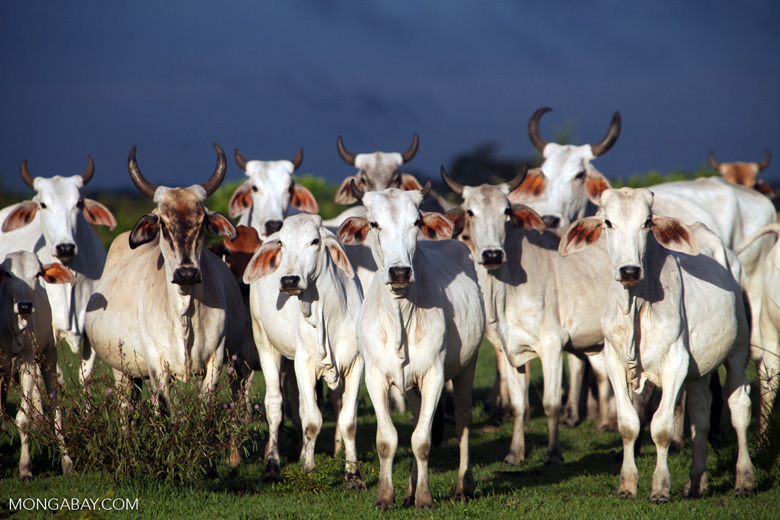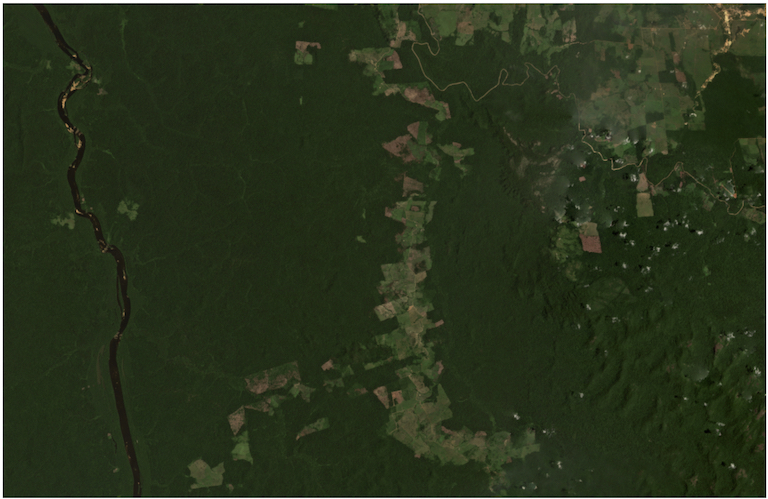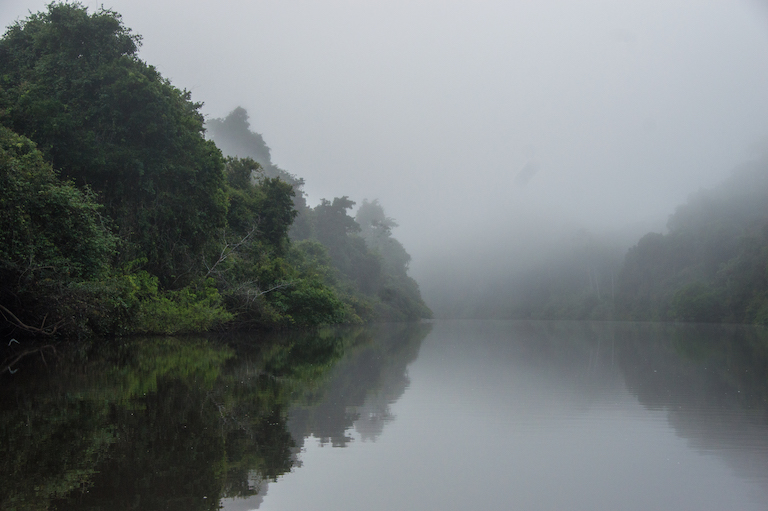‘Rampant Forest Destruction’ Wracks Reserve as Cattle Ranching Advances in Brazilian Amazon
ENVIRONMENT, 3 Jan 2022
Morgan Erickson-Davis and Ana Ionova | Mongabay - TRANSCEND Media Service
29 Dec 2021
- The Terra do Meio Ecological Station comprises some 3.37 million hectares in the Brazilian Amazon state of Pará, and is home to hundreds of species – including some that are threatened with extinction.
- But despite its protected status, Terra do Meio has come under growing pressure, with satellite data showing deforestation doubling in 2021.
- Environmentalists say the destruction within Terra do Meio is being driven by illegal loggers, cattle ranchers and land speculators spilling over from the neighboring Área de Proteção Ambiental (APA) Triunfo do Xingu, a sustainable use reserve that has become the most deforested slice of the Brazilian Amazon in recent years.
- Pending legislation could make it even easier to legalize illegitimate land claims, providing hope to land speculators and cattle ranchers that they could soon receive land titles for land they have deforested and occupied illegally.
The lush rainforest stretches for miles across the Terra do Meio Ecological Station, in Brazil’s northern state of Pará. Near the edge of the vast protected reserve, a makeshift road slices through the thick emerald canopy. Flanking it are swaths of freshly cleared land, spanning hundreds of hectares. Further south, forest is being replaced by neat patches of pasture.
The Terra do Meio reserve is a federally protected area spanning 3.37 million hectares (8.3 million acres) across the Amazon state of Pará. It is home to hundreds of species, including some of which, such as the margay (Leopardus wiedii) – a small, nocturnal wild cat native to Central and South America – are threatened with extinction. The reserve is also part of the Xingu Basin, an ecologically rich mosaic made up of 28 conservation areas and 18 Indigenous territories.
But, despite its protected status, the Terra do Meio reserve has come under growing pressure. Between Jan. 1 and Dec. 14, some 25,943 deforestation alerts were confirmed in primary forest within it, according to satellite data from the University of Maryland visualized on Global Forest Watch. And data from Brazil’s space research agency, INPE, showed that some 2,963 hectares of forest were cleared within the reserve this year, nearly double the area deforested in 2020.

“This is a region that should be completely preserved,” said Rômulo Batista, campaigner with Greenpeace Brazil. “There should be zero deforestation there. But instead, we are seeing rampant forest destruction, which is really worrying.”
As deforestation advances within the Terra do Meio reserve, the plots being razed are becoming larger too, according to Edenise Garcia, science director at The Nature Conservancy, a nonprofit monitoring deforestation in the region. The biggest patch of land deforested in the reserve totaled some 463 hectares this year, up from about 280 hectares the year before, Garcia said.
“The deforestation is becoming more and more noticeable – in other words, they’re becoming bolder,” she told Mongabay in a phone interview. “It’s a warning that these people are going in to clear larger and larger plots of land.”
Swaths of the reserve have also been burned this year, and satellite data from NASA show fire alerts coinciding with deforestation alerts. Most of these occurred in August and September, the dry season when most illegal burning takes place across the Amazon.

Environmentalists say the destruction within Terra do Meio is being driven by illegal loggers, cattle ranchers and land speculators. And they warn that much of the deforestation is spilling over from the neighboring Área de Proteção Ambiental (APA) Triunfo do Xingu, a sustainable use reserve that has become the most deforested slice of the Brazilian Amazon in recent years.
“It should be serving as a buffer shielding the areas that are under stricter protection,” said Larissa Amorim, a researcher at Imazon, an NGO monitoring the forest clearing. “But unfortunately, deforestation has already practically taken over the Triunfo do Xingu. And, now, it’s advancing beyond it.”
Advocates warn that the invasions are threatening Terra do Meio’s biodiversity, while also opening up the broader ecological mosaic to deforestation and destruction. Other protected areas that lie beyond the reserve, like the Kayapo and Kararaô Indigenous Territories, are already coming under attack.
“These are regions that have the greatest ecological importance and that must be protected to ensure the integrity of the rainforest as a whole, ” Batista said. “And this is what we are ultimately losing with this surge in deforestation.”
Destruction next door
The Terra do Meio reserve is nestled deep in Brazil’s cattle heartland, straddling the municipalities of Altamira and São Félix do Xingu. In this corner of the Amazon, the economy is fueled by ranching: São Félix do Xingu is home to some 2.3 million head of cattle, Brazil’s largest herd.

Much of this cattle ranching is clustered within the APA Triunfo do Xingu, where authorities allow land-holders to deforest and develop a fifth of their land if they promise to preserve the rest. When it was created over a decade ago, Triunfo do Xingu was intended as a shield for vulnerable areas beyond its boundaries, like the Apyterewa Indigenous Territory and the Terra do Meio Ecological Station.
But, amid lax monitoring and enforcement, large-scale deforestation within Triunfo do Xingu has skyrocketed, with most of the land turned into pasture. This year alone, it was responsible for a tenth of Pará’s deforestation, with about half of the destruction driven by just 10 large property-holders, according to Garcia. About 40% of Triunfo do Xingu’s forests have already been cleared and it now tops Brazil’s list of most deforested protected reserves.
“The Triunfo do Xingu APA was created to allow some kind of human activity in a sustainable way,” Amorim said. “But we see that it is not sustainable at all. And the illegal activities that are taking place there end up spilling beyond it.”
The destruction next door has had a devastating impact on the Terra do Meio reserve, environmentalists say. As forest is converted to pasture, reserves beyond the Triunfo do Xingu – including the Terra do Meio – are becoming more easily accessible to outsiders, allowing them to invade deeper into the forest.

This seems to be echoed by the pattern of deforestation seen within the Terra do Meio reserve. At least half a dozen roads have been carved into the territory so far, according to satellite images. And much of the fresh clearing this year has been clustered around one clandestine road halting at the APA’s doorstep, according to Garcia.
“What we may be seeing is an opening for selective timber extraction, which is the first step towards deforestation,” she said. “And as the forest becomes more degraded, people come in and cut the rest to put cattle there.”
As the buffer zone retreats, the ecological corridor that the Terra do Meio reserve is part of is left more vulnerable too. With the dense forest in this reserve thinning, invaders in search of new areas to exploit can more easily reach other protected areas like the Xipaya, Baú, and Cachoeira Seca do Iriri Indigenous Reserves.
“The illegal loggers and land speculators are taking advantage of this opportunity to make inroads, to make this particular area more accessible,” Amorim said.
Environmental advocates also worry that the deforestation slicing through Terra do Meio on the west could soon join a wave of forest clearing advancing from the southeast through the Iriri State Forest. That frontier of deforestation is being driven by clearing along the BR-163 highway, according to environmentalists.
Scientists warn that if the habitat corridor continues to fragment, some species may struggle to survive in the remaining slivers of rainforest, dealing a blow to biodiversity. The splintering of the forest may also make it more difficult for Indigenous and traditional people who rely on hunting in large swaths of the Amazon for their survival.

The fragmentation of the rainforest in this region will also likely lead to a shift in local climate patterns, resulting in less rainfall and dwindling water sources, said Thaise Rodrigues, a researcher with the Rede Xingu+, a network of environmental and Indigenous groups working in the Xingu Basin.
“We are already seeing that the forest is getting drier,” Rodrigues told Mongabay in a phone interview. “This will influence the water quality in the region. And this is the same water that Indigenous people and traditional communities in the forest use to bathe, to drink, to fish.”
Promise of amnesty
Environmental advocates blame the surge in invasions ravaging the Terra do Meio reserve on a series of friendly signals from the federal government, which they say has encouraged invaders to encroach on protected areas without fear of punishment.
“When you have a fragile system of command and control, you are not curbing deforestation, you’re not curbing illicit activities,” Garcia said. “On the contrary – these opportunistic groups end up realizing that it is easy to deforest within conservation areas.”

President Jair Bolsonaro has repeatedly promised to open up protected areas and Indigenous reserves to mining, ranching and agriculture. Under his watch, cumulative deforestation in Brazil’s Amazon hit its highest level since 2006 this year. Protected areas such as Terra do Meio have come under particularly heavy pressure from invasions. Forest destruction within reserves has jumped by nearly one-third.
A long-time proponent of developing the Amazon, Bolsonaro has slashed budgets for environmental policing, fired top agents at federal enforcement agencies, and moved to obstruct the system of environmental fines by allowing offenders to dispute them. Fines punishing such crimes have plunged to their lowest level in 24 years.
“On the one hand, you have a discourse that favors and encourages land-grabbing,” said Rodrigues. “And on the other hand, you have the weakening of the institutions responsible for controlling this. So, it’s only natural that deforestation in protected areas has increased really dramatically.”
Under pressure from the international community, Bolsonaro recently softened his tone and vowed to eliminate illegal deforestation in less than a decade. The federal government has pointed to a 19% drop in deforestation for the month of November as proof that it is moving in the right direction.

This month, Brazil’s environmental ministry also told Mongabay that a larger budget in 2021 allowed it to double its spending on enforcement, including the purchase of equipment, vehicles and navigation systems. It said it is “strengthening the fight against illegal deforestation” and it is in the process of hiring 739 new inspection officers at Ibama and ICMBio, Brazil’s two federal enforcement agencies.
Still, environmentalists say the government’s efforts have fallen short in curbing forest destruction, claiming that enforcement efforts have focused on ineffective large-scale crackdowns rather than consistent policing.
“Enforcement must be more rigorous in these areas,” Amorim said. “Policing is taking place in the Amazon, we cannot say it doesn’t occur. But it hasn’t been intense and persistent enough to tackle the scale of the deforestation problem.”
Between August 2019 and July 2021, the federal government spent some R$550 million ($97.7 million) on massive military operations aimed at combating deforestation in the Amazon. During its high-profile Operation Green Brazil 2, which ended this year, agents carried out 105,000 inspections, seizing 506,000 cubic meters of illegal timber and handing out 5,480 fines totaling some R$3.3 billion ($583.6 million), according to government figures.

The head of the military recently touted these operations as a major success, crediting them with reducing deforestation in the Amazon dramatically. Yet, according to official INPE data, forest destruction actually rose 22% over the course of the operations.
Meanwhile, environmentalists say a pair of legislative proposals currently moving through Brazil’s Senate have also undermined efforts to stop incursions into the forest. If approved, these two land reform bills could make it easier to legalize illegitimate land claims.
This has bolstered hopes among land speculators and cattle ranchers that they could soon receive land titles for land they have deforested and occupied illegally, Batista said, fueling invasions of reserves like Terra do Meio.
“This legislation could mean those who invaded areas illegally end up winning amnesty for it,” he said. “When they invade, this is what they are betting on.”
______________________________________________
Editor’s note: This story was powered by Places to Watch, a Global Forest Watch (GFW) initiative designed to quickly identify concerning forest loss around the world and catalyze further investigation of these areas. Places to Watch draws on a combination of near-real-time satellite data, automated algorithms and field intelligence to identify new areas on a monthly basis. In partnership with Mongabay, GFW is supporting data-driven journalism by providing data and maps generated by Places to Watch. Mongabay maintains complete editorial independence over the stories reported using this data.
Morgan Erickson-Davis has been writing for Mongabay since 2008 and came on full-time in 2014. Trained in biology, she has taken any available opportunity to learn more about the world, from working as a fisheries biologist aboard longliners and freighters in the South Pacific to evaluating river health in western Montana. She spent eight years editing technical papers before jumping into journalism, with more than 50 manuscripts under her belt. Currently, Morgan manages Mongabay‘s forests and global palm oil reporting programs.
 Ana Ionova is a freelance multimedia journalist covering the environment, human rights and politics in Brazil. Her work has been published by Reuters, The New York Times, Foreign Policy, Al Jazeera and others. She has previously worked in Argentina, the Balkans and the Middle East.
Ana Ionova is a freelance multimedia journalist covering the environment, human rights and politics in Brazil. Her work has been published by Reuters, The New York Times, Foreign Policy, Al Jazeera and others. She has previously worked in Argentina, the Balkans and the Middle East.
Tags: Amazonia, BRICS, Bolsonaro, Brazil, CO2, Carbon source, Cattle and Ranch Farmers, Climate Change, Corruption, Deforestation, Environment, Forest fires, Global warming, Greenpeace, Human Rights, Indigenous Rights, JBS, Latin America Caribbean, Meat Industry, Nature's Rights, Rain Forests, Resources, Violent conflict
DISCLAIMER: The statements, views and opinions expressed in pieces republished here are solely those of the authors and do not necessarily represent those of TMS. In accordance with title 17 U.S.C. section 107, this material is distributed without profit to those who have expressed a prior interest in receiving the included information for research and educational purposes. TMS has no affiliation whatsoever with the originator of this article nor is TMS endorsed or sponsored by the originator. “GO TO ORIGINAL” links are provided as a convenience to our readers and allow for verification of authenticity. However, as originating pages are often updated by their originating host sites, the versions posted may not match the versions our readers view when clicking the “GO TO ORIGINAL” links. This site contains copyrighted material the use of which has not always been specifically authorized by the copyright owner. We are making such material available in our efforts to advance understanding of environmental, political, human rights, economic, democracy, scientific, and social justice issues, etc. We believe this constitutes a ‘fair use’ of any such copyrighted material as provided for in section 107 of the US Copyright Law. In accordance with Title 17 U.S.C. Section 107, the material on this site is distributed without profit to those who have expressed a prior interest in receiving the included information for research and educational purposes. For more information go to: http://www.law.cornell.edu/uscode/17/107.shtml. If you wish to use copyrighted material from this site for purposes of your own that go beyond ‘fair use’, you must obtain permission from the copyright owner.
